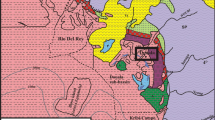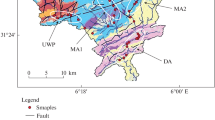Abstract
Clay-rich deposits of Upper Cretaceous levels in the Taveiro (Reveles and S. Pedro) and Aveiro (Bustos) regions of west-central Portugal are economically and environmentally important, but detailed chemical and mineralogical characterization is lacking. The purpose of this study was to partially fill that gap by correlating the trace-element geochemistry (particularly the rare earth elements, REE) with the mineralogy of both the whole rock and of the <2 μm fraction along selected stratigraphic levels of the formations. The results will help the ceramics industry in the region and will be important in paleoreconstruction environmental studies.
Mineralogical and chemical characterizations were carried out using X-ray diffraction (XRD), X-ray fluorescence (XRF), and instrumental neutron activation analysis (INAA). The following clay-mineral associations were identified: (1) at Reveles — smectite, illite, and kaolin minerals; (2) at S. Pedro — kaolin minerals and illite; and (3) at Bustos — illite, kaolin minerals, and mixed-layer illite-smectite. The distribution of trace elements in the <2 μm fraction depended on the clay mineralogy, suggesting that the trace elements were incorporated in, adsorbed to, or even replaced major elements in the clays, as follows: (1) first-row transition elements, particularly Zn and Ga, were enriched when smectite predominated; (2) As, Rb, and Cs were enriched in this fraction of the S. Pedro deposit, the only one with Fe (oxyhydr)oxides and a high proportion of illite; and (3) REE were more concentrated when kaolin minerals predominated. Eu was enriched in the <2 μm fraction, which was due to preferential incorporation in the Fe (oxyhydr)oxides and/or carbonates.
Similar content being viewed by others
References
Azeredo, A., Ramalho, M., and Wright, V.P. (1998) The Middle-Upper Jurassic disconformity in the Lusitanian basin, Portugal: preliminary facies analysis and evidence for palaeoclimatic fluctuation. Cuadernos de Geologia, 24, 99–119.
Bradbury, M.H. and Baeyens, B. (2000) A generalised sorption model for the concentration dependent uptake of caesium by argillaceous rocks. Journal of Contaminant Hydrology, 42, 141–163.
Brindley, G.W. and Brown, G. (1980) Crystal Structures of Clay Minerals and their X-ray Identification. Monograph 5, Mineralogical Society, London.
Compton, J.S., White, R.A., and Smith, M. (2003) Rare earth element behavior in soils and salt pan sediments of a semiarid granitic terrain in the Western Cape, South Africa. Chemical Geology, 201, 239–255.
Coroado, J.P.P.F. (2000) Propriedades cerâmicas das argilas das unidades litoestratigráficas Argilas de Aveiro e Argilas de Tomar. PhD thesis, University of Aveiro, Portugal.
Cox, R., Low, D.R., and Cullers, R.L. (1995) The influence of sediment recycling and basement composition on evolution of mudrock chemistry in the southwestern United States. Geochimica et Cosmochimica Acta, 59, 2919–2940.
Cullers, R.L. (2002) Implications of elemental concentrations for provenance, redox conditions, and metamorphic studies of shales and limestones near Pueblo, CO, USA. Chemical Geology, 191, 305–327.
Cullers, R.L. and Berendsen, P. (1998) The provenance and chemical variation of sandstones associated with the Midcontinent rift system, USA. European Journal of Mineralogy, 10, 987–1002.
Cullers, R.L., Bock, B., and Guidotti, C. (1997) Elemental distributions and neodymium isotopic compositions of Silurian metasediments, western Maine, USA: Redistribution of the rare earth elements. Geochimica et Cosmochimica Acta, 61, 1847–1861.
Dias, M.I. and Prudêncio, M.I. (2008) On the importance of using scandium to normalize geochemical data preceding multivariate analyses applied to archaeometric pottery studies. Microchemical Journal, 88, 136–141.
Dinis, J.L., Rey, J., Cunha, P.P., Callapez, P., and Pena dos Reis, R. (2008) Stratigraphy and allogenic controls of the western Portugal Cretaceous: an updated synthesis. Cretaceous Research, 29, 772–780.
Galhano, C., Rocha, F., and Gomes, C. (1999) Geostatistical analysis of the influence of textural, mineralogical and geochemical parameters on the geotechnical behaviour of the “Argilas de Aveiro” formation (Portugal). Clay Minerals, 34, 109–116.
Gouveia, M.A., Prudêncio, M.I., Freitas, M.C., Martinho, E., and Cabral, J.M.P. (1987) Interference from uranium fission products in the determination of rare earths, zirconium and ruthenium by instrumental neutron activation analysis in rocks and minerals. Journal of Radioanalytical and Nuclear Chemistry, 2 (Articles 14), 309–318.
Gouveia, M.A., Prudêncio, M.I., Morgado, I., and Cabral, J.M.P. (1992) New data on the GSJ reference rocks JB-1a and JG-1a by instrumental neutron activation analysis. Journal of Radioanalytical and Nuclear Chemistry, 158, 115–120.
Govindaraju, K. (1994) Compilation of working values and sample description for 383 geostandards. Geostandards Newsletter, 18, 1–158.
Haskin, L.A., Helmmke, P.A., Paster, T.P., and Allen, R.O. (1971) Activation Analysis in Geochemistry and Cosmogeochemistry (A.O. Brunfelt and E. Steinnes, editors). Universitetsforlaget, Oslo, pp. 201–218.
Kleeberg, R., Monecke, T., and Hillier, S. (2008) Preferred orientation of mineral grains in sample mounts for quantitative XRD measurements: How random are powder samples? Clays and Clay Minerals, 56, 404–415.
Lin, Z. and Puls, R.W. (2000) Adsorption, desorption and oxidation of arsenic affected by clay minerals and aging process. Environmental Geology, 39 (7), 753–759.
Marques, R. (2007) Geoquimica e mineralogia de argilas do Cretácico de Taveiro e Aveiro, Portugal. MSc thesis, University of Aveiro, Portugal, 109 pp.
Martinho, E., Gouveia, M.A., Prudêncio, M.I., Reis, M.F., and Cabral, J.M.P. (1991) Factor for correcting the ruthenium interference in instrumental neutron activation analysis of barium in uraniferous samples. Applied Radiations and Isotopes, 42, 1067–1071.
McLennan, S.M. (1989) Rare earth elements in sedimentary rocks: influence of provenance and sedimentary processes. Pp. 169–200 in: Geochemistry and Mineralogy of the Rare Earth Elements (I.R. Lipin and G.A. McKay, editors). Reviews in Mineralogy, 21, Mineralogical Society of America, Washington, D.C.
Moore, D.M. and Reynolds, R.C. (1997) X-ray Diffraction and the Identification and Analysis of Clay Minerals, 2nd edition. Oxford University Press, New York, 378 pp.
Oliveira, A., Rocha, F., Rodrigues, A., Jouanneau, J., Dias, A., Weber, O., and Gomes, C. (2002) Clay minerals from the sedimentary cover from the Northwest Iberian shelf. Progress in Oceanography, 52, 233–247.
Papoulis, D., Tsolis-Katagas, P., and Katagas, C. (2004) Monazite alteration mechanisms and depletion measurements in kaolins. Applied Clay Science, 24, 271–285.
Proença Cunha, P. and Pena dos Reis, R.P.B. (1995) Cretaceous sedimentary and tectonic evolution of the northern sector of the Lusitanian basin (Portugal). Cretaceous Research, 16, 155–170.
Prudêncio, M.I. and Cabral, J.M.P. (1988) Rare earths and other trace elements in Cretaceous clays from Central Portugal. Journal of Radioanalytical and Nuclear Chemistry, 123, No1, 309–320.
Prudêncio, M.I., Gouveia, M.A., and Cabral, J.M.P. (1986) Instrumental neutron activation analysis of two French geochemical reference samples - basalt BR and biotite Mica-Fe. Geostandards Newsletter, X, 29–31.
Prudêncio, M.I., Figueiredo, M.O., and Cabral, J.M.P. (1989) Rare earth distribution and its correlation with clay mineralogy in the clay-sized fraction of Cretaceous and Pliocene sediments (central Portugal). Clay Minerals, 24, 67–74.
Prudêncio, M.I., Sequeira Braga, M.A., Oliveira, F., Dias, M.I., Delgado, M., and Martins, M. (2006) Raw material sources for the Roman Bracarense ceramic (NW Iberian Península). Clays and Clay Minerals, 54, No. 5, 639–651.
Rocha, F.T. (1993) Argilas aplicadas a estudos litoestratigráficos e paleoambientais na bacia sedimentar de Aveiro. PhD thesis, University of Aveiro, Portugal.
Rocha, F. and Gomes, C. (1995) Paleoenvironmental reconstruction of the Aveiro region during Cretaceous based on clay mineralogy. Cretaceous Research, 16, 187–194.
Santos, M.H. (1998) Potencialidades de argilas portuguesas para o uso como materiais de selagem em sistemas geoambientais de confinamento de resíduos. MSc thesis, University of Aveiro, Portugal.
Santos, M.H., Rocha, F., and Gomes, C. (2000) Assessment of some relevant properties of the “Argilas de Taveiro” formation (Coimbra, Portugal) in order to be used as liners in land-fills. Geociências, Revista Universidad Aveiro, vol 14, fasc (1/2).
Schultz, L.G. (1964) Quantitative interpretation of mineralogical composition X-ray and chemical data for the Pierre Shale. Geological Survey 391 pp.
Setti, M., Marinoni, L. and Loópez-Galindo, A. (2004) Mineralogical and geochemical characteristics (major, minor, trace elements and REE) of detrital and authigenic clay minerals in a Cenozoic sequence from Ross Sea, Antarctica. Clay Minerals, 39, 405–421.
Statsoft, Inc. (2008) Statistica (data analysis software system), version 8.0. www.statsoft.com.
Terroso, D. (2005) Argilas/Lamas e Águas Termais das Furnas (Açores): avaliação das propriedades físicas e químicas relevantes para a utilização em Peloterapia. MSc thesis, University of Aveiro, Portugal.
Thorez, J. (1976) Practical Identification of Clay Minerals. G. Lelotte, Dison, Belgium.
Wronkiewicz, D.J. and Condie, K.C. (1990) Geochemistry and mineralogy of sediments from the Ventersdorp and Transvaal Supergroups, South Africa: cratonic evolution during the early Proterozoic. Geochimica et Cosmochimica Acta, 54, 343–354.
Zachara, J.M., Smith, S.C., Liu, C., Mckinley, P., Serne, R.J., and Gassman, P.L. (2002) Sorption of Cs+ to micaceous subsurface sediments from the Hanford site, USA. Geochimica et Cosmochimica Acta, 66, 193–211.
Author information
Authors and Affiliations
Corresponding author
Rights and permissions
About this article
Cite this article
Marques, R., Dias, M.I., Prudêcio, M.I. et al. Upper Cretaceous Clayey Levels from Western Portugal (Aveiro and Taveiro Regions): Clay Mineral and Trace-Element Distribution. Clays Clay Miner. 59, 315–327 (2011). https://doi.org/10.1346/CCMN.2011.0590307
Received:
Revised:
Published:
Issue Date:
DOI: https://doi.org/10.1346/CCMN.2011.0590307




